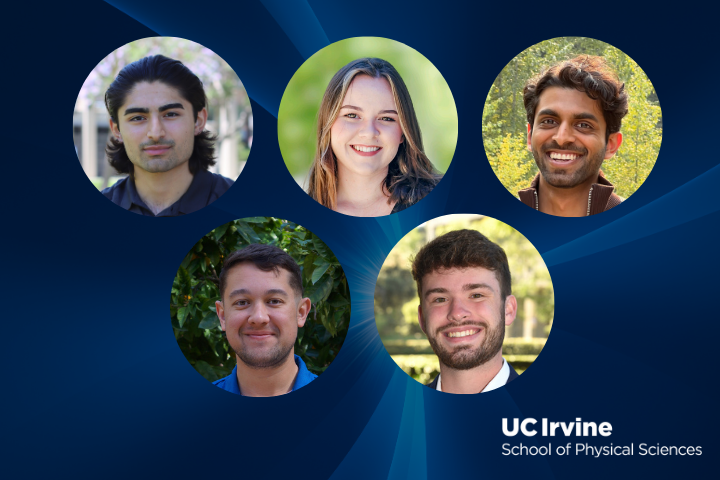National Science Foundation awards five additional Graduate Research Fellows for School of Physical Sciences

The new NSF GRFP fellows at the UC Irvine School of Physical Sciences. Clockwise from top left: Massee Akbar, Emma Brass, Jay Kirshnan, Silas Scribner, Chad Moorman.
In March, the National Science Foundation announced the first round of recipients of their prestigious Graduate Research Fellowship Program (GRFP) awards. The five-year program provides three years of funding support for students, as well as opportunities for international research involvement. Three graduate students from the UC Irvine School of Physical Sciences were awarded in the first round, and five more were awarded in the second round, announced in June.
Massee Akbar, Physics & Astronomy
Massee Akbar graduated with his bachelor’s in physics from the UC Irvine Department of Physics & Astronomy this June, and is beginning a Ph.D. this fall in the lab of Professor Howard Lee. Lee’s group focuses on the development of nano-scale technologies, many of which have medical applications. For his NSF-supported research, Akbar will be working to turn optical fibers as thin as a strand of human hair into fully functioning microscopes. Using a 3-D printer, Akbar will print what he described as a “nanophotonic” pattern on the tip of the fibers that will enable him and his lab to control light without the need for bulky lenses. The work could one day allow for medical cameras to enter human tissues without causing any harm to the patient.
“Shrinking a full microscope down to fiber size could let surgeons watch individual neurons fire, or spot cancer cells in places today’s scopes simply can’t reach,” said Akbar. “The same nanophotonic devices will scale and enhance the data capacity of the internet’s backbone of optical fibers. In short, this technology opens doors in both medicine and communications, which is exactly the kind of high impact leap NSF likes to seed.”
Emma Brass, Chemistry
Emma Brass is a third-year doctoral student in the lab of Professor Matthew Sheldon in the UC Irvine Department of Chemistry. Sheldon’s lab researches the optics of nano-scale materials with applications in harvesting solar energy. For her NSF-funded research, Brass is investigating the thermal properties of something called perovskite quantum dots – nanocrystals with conductive capabilities commonly used in solar cell technology. Brass will be studying how to harness light to help keep the crystals cool, which could help usher in a new generation of solar harnessing tech.
“Optical cooling in perovskite quantum dots is a unique process, and the mechanisms through which it occurs are still largely unknown,” said Brass. “This work could help us understand and optimize this rare form of light-driven cooling in materials that are already used in LEDs and solar cells. If successful, it could lead to new ways to manage heat in electronics or even harvest waste heat using light, opening the door to more efficient, thermally self-regulating technologies.”
Jay Krishnan, Physics & Astronomy
Jay Krishnan received his bachelor's in physics from the UC Irvine Department of Physics & Astronomy in 2022. As a doctoral student in Kevork Abazajian’s group, Krishnan’s research focuses on the study of galaxies that formed just a few hundred million years after the Big Bang, and how those galaxies inform current models for how the universe formed. “These galaxies seem way too massive for how far away they are, which means they formed very early in cosmic history,” said Krishnan. “Our models suggest there hasn't been enough time for that much matter to come together so soon to form these galaxies. I'm testing whether these galaxies can be explained by Lambda-CDM (our standard cosmological model) when all sources of uncertainty are taken into account, or if we need to turn to alternative cosmological models.”
Lambda-CDM, Krishnan added, faces several challenges. There are subtle disagreements between different measurements of the expansion rate of the universe, and the data gleaned from older galaxies is adding to researchers’ confusion in unique ways. “Testing new models that could explain all of these issues is really important if we want to understand how the universe actually works,” he said.
Chad Moorman, Chemistry
Chad Moorman is a Ph.D. candidate in the lab of Professor Matt Griffin in the UC Irvine Department of Chemistry. Griffin’s lab researches the human microbiome – the trillions of microbes in human guts that have no genetic relation to us, but which are critical for the healthy functioning of our bodies. For his NSF-supported research, Moorman is studying probiotics and how they do or do not enhance the health of the microbiome at the molecular level.
“The human gut is composed of trillions of microbes whose composition has been correlated to a variety of health outcomes for the host,” said Moorman. “It’s known that the diverse polysaccharides created by different gut bacteria can activate host immune systems. However, the molecular mechanisms for how these microbial glycans are being sensed by our immune system remain unclear. My project seeks to address this by identifying and characterizing the host receptors and pathways that are responsible.”
Silas Scribner, Chemistry
Silas Scribner is a second-year doctoral student in the lab of Professor Vy Dong in the UC Irvine Department of Chemistry. In Dong’s lab, Scribner is working to develop pharmaceuticals using rare earth elements. As an NSF fellow, Scribner will be studying how rare earth metals – specifically, a metal called yttrium – can function as especially-powerful catalysts in medicinal drugs. “Many pharmaceutically relevant molecules are chiral– that is, they can exist as left- and right-handed versions with identical connectivity, but with vastly different biological properties,” said Scribner. “Constructing these molecules selectively is the subject of ongoing research, but chiral organophosphorus compounds remain a significant synthetic challenge.”
Scribner explained that previous methods for synthesizing such compounds require long reaction times, extremely cold temperatures, and they generate large amounts of waste products. His yttrium-based proposal involves a fast, efficient and scalable method for rapidly building up complex chiral organophosphorus species.
Honorable mentions
Yuwen Wang, Chemistry
